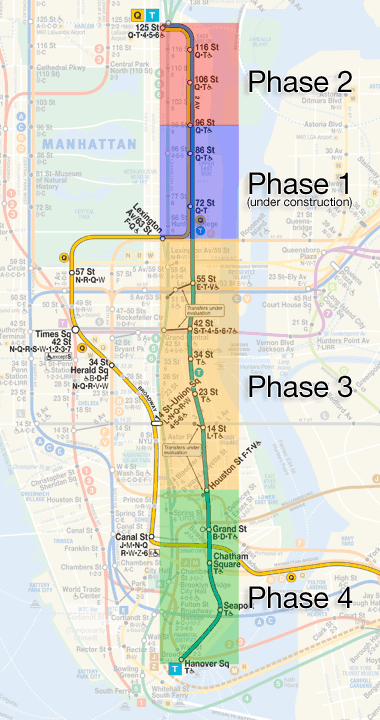A Guide To NYC Public Transportation
/I've been working on a series here for tips for common tourist concerns. I recently did a post on the most common street scams to avoid in NYC (hint: anyone tries to hand you anything? keep walking!). Today, I present my tips & guide to using public transportation in New York.
Public transportation is the best way to get around New York, and the best way to experience the city as the locals do (locals rarely take cabs). It can seem intimidating at first, but follow our guide, and you’ll be in the know in no time.
Know the map.
Download a copy of the NYC subway map to your smartphone (physical copies are available at most station booths, if you can find one). A PDF is here. Keep track of service changes on the MTA website. Weekend-specific changes (which occur every weekend, so be prepared!) are available here. Google Maps also now provides a public transit option, in addition to car and walking directions.
Also note that some subway stations have separate entrances (and platforms) for uptown trains versus downtown trains. Check signs to make sure you are headed the right way.Metrocard.
First thing you must know is that NYC has a flat-fare system. Unlike most cities where your fare is based on zones/distance traveled, there is one flat fare for NYC, no matter you destination. Simply swipe in to the system, and you are in at that one fare until you exit... transfers to other lines (through connected stations) have no additional cost. Within around 2 hours, you can also transfer to a bus with your Metrocard at no additional cost. The standard fare is now $2.75
You can purchase Metrocards in every station at the vending machines, or from an attended booth. Some station entrances may not have a machine, if so, simply go back out and enter the station at the main entrance.
There are a couple of different types of Metrocards available (info here). The first is the Pay-Per-Ride Metrocard, in which you put a certain amount of $$ on the card, and your fare total is deducted for every swipe. This is good for several people to share. The second type is an Unlimited Metrocard, in which you pay a flat fee and get unlimited swipes for a certain period... 7 days, or 30 days. These unlimited cards can not be shared as, after your swipe, the card will be locked out for about 15 minutes. If you will be in NYC for around a week, we highly recommend purchasing the 7-day Unlimited Metrocard for every member of your group or family.
When swiping your Metrocard at a turnstile, a swift and straight swipe will avoid read errors.JFK AirTrain.
The AirTrain monorail system provides a connection between JFK airport and two nearby transit hubs (check signs to make sure you are headed the right way)... Howard Beach (with access to the A train), and Jamaica (access to E and J lines, plus access to Long Island Railroad). Payment for the AirTrain is by Metrocard (pay-per-ride cards only). It is $5 each way.
It also provides connections between terminals inside the airport at no cost.The different systems.
The main NYC transit system-- ie. what your Metrocard will pay for-- consists of the following: the subways, city bus lines, and the Roosevelt Island tramway (info on the latter here). But there are several other transportation options in the city that your Metrocard will not cover, and will require separate fares. Here's a primer:
A) NYC Ferry: NYC's new, official ferry service is a great way to travel between the city's waterfront areas. The fare is the same price as a subway ride-- $2.75-- but requires a separate ticket.
There are also other ferry options, such as NY Waterway and NY Water Taxi.
(not even including the many sightseeing boat/cruise companies)
B) Long Island Rail Road: The LIRR is a commuter train system that connects NYC to the suburbs of Nassau and Suffolk Counties (collectively known as Long Island). To ride this system, a separate ticket must be purchased at stations. If you do wish to ride a LIRR train, please buy a ticket in advance, as purchasing tickets on board is almost double the cost of an advance ticket.
C) Metro-North: Metro-North railroad connects NYC to its far outer suburbs of upstate New York and Connecticut. As with LIRR, tickets should be purchased before boarding.
D) PATH: Path trains connect certain lower Manhattan neighborhoods to specific areas of New Jersey popular with cross-state commuters... Hoboken, Jersey City, and access to Newark Airport. The Path system does take Metrocards, but only pay-per-ride cards (unlimited Metrocards not accepted), though there is no free transfer between Path and the NYC transit system.
E) NJ Transit: NJ Transit is a commuter rail system that connects NYC (via Penn Station) to cities all across New Jersey.
F) Staten Island Ferry: The commuter boat between Manhattan and Staten Island. This one, as you may know, is free and requires no tickets.Getting help.
Should you find yourself with questions during your travels, you have many options. First is to just ask! Contrary to stereotypes, most New Yorkers are very friendly and happy to assist (except maybe during rush hour). Second, check the web! All underground stations now have free wifi service. Finally, find an MTA employee! It is their job to help point you in the right direction.
We hope this helps, and safe travels!




